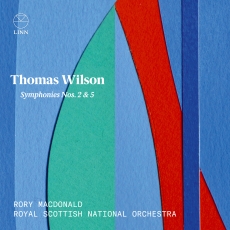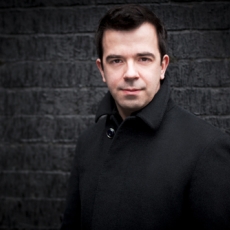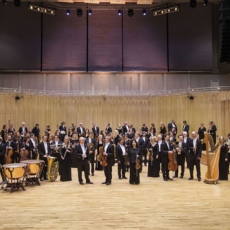Rory Macdonald & RSNO - Thomas Wilson: Symphonies Nos. 2 & 5 - Music Web International [RH]
This disc completes Linn’s survey of Thomas Wilson’s four extant symphonies: numbers 3 and 4 emerged last year coupled with the celebratory Glasgow (the composer’s home city) homage Carillon on CKD 616 (review), whilst Wilson’s first attempt at the form went the same way as everything this particularly self-critical figure composed prior to 1958 – into his metaphorical bottom drawer, presumably to remain there in perpetuum. Unlike Carillon and Passaleth Tapestry(Wilson’s superb fourth symphony which constitutes a kind of portrait-in-sound of the nearby city of Paisley), the two offerings here are seemingly completely abstract, non-programmatic works, although according to the booklet-note Wilson did identify a ‘Scottish dimension’ within his music, although this is never obvious for the dispassionate listener. Perhaps I’m stereotyping, but I wonder if he was referring to an uncompromising Glaswegian ‘toughness’? Make no mistake; both these symphonies make for rather rugged listening, although Wilson’s crystalline structures and painterly timbral skills are most conspicuous and ensure an exhilarating ride.
The Symphony No 2 was premiered in 1965 by James Loughran and the BBC Scottish Symphony Orchestra in a concert broadcast from Glasgow. Paul Conway reports that the work drew rave reviews and provided something of a springboard for the composer in terms of attracting new commissions. Listening to the symphony prior to consulting the booklet, I was a little surprised to find the work wasn’t actually premiered in Cheltenham, as to my ears it projects the archetypal ‘Cheltenham Symphony’ sound – grey, austere, granitic even. Of course this phrase is both patronising and unbearably pejorative, and I happen to admire the majority of the works that I have heard over the years which have been labelled thus (my colleague John France eloquently considers this phenomenon here). Perhaps the perceived aesthetic overlaps with a very specific point in British (as opposed to English) history; in my mind‘s eye I can easily visualise (in gritty monochrome, of course) growing up amid the post-war reconstruction of Stockport and Wilson’s Symphony No 2 would certainly provide an apt soundtrack for that particular (oddly reassuring) visual narrative.
It’s cast in three movements; the first (marked Poco Adagio - Allegro potente) begins in the depths, with gloomy basses, pensive bassoon and a pizzicato episode. What follows is derived organically from this; the music is terse, mobile and magnificently orchestrated. The Royal Scottish National Orchestra have once again been fastidiously prepared and (unsurprisingly for a Linn disc) sound magnificent under Rory Macdonald. When the Allegro potente section kicks off the developmental potential of Wilson’s somewhat gloomy introductory idea becomes apparent. A brief moment of levity at 3:58 soon yields to music of great seriousness. Wilson mines a surprising variety of colour from what appears to be a pretty standard-sized orchestra; his spiky piano writing recalls Stravinsky and the palette is extended by the composer’s frequent reference to sinuous solo instrumental lines – the principal cellist, oboist and flautist have much to do (and they do it wonderfully). The final minute or so of the movement reveals the massive dynamic range in the Linn recording. The Adagio – Scherzo – Allegro leggiero marking attached to the central panel implies an arc from slow to fast although it doesn’t really turn out that way. At first lonely woodwind lines rub shoulders with atmospheric string tremolandi, a backcloth which is occasionally pock-marked by tuned percussion and piano and results in music which seems to pose bleak, existential questions. The faster music which follows is livelier but quite without jollity. It soon returns to the pace of the opening. There are again notable solo episodes for cello and cor anglais. The Allegro finale is at once more purposeful and decisive. Its second idea is unexpectedly presented by xylophone and piano. Paul Conway contends that the movement represents, at the last gasp, a successful resolution of the work’s introductory material – its hard-won positivity is stylistically similar to many of Alan Rawsthorne’s symphonic and concertante finales.
Wilson’s Symphony No 5 of 1998 was his swansong. It requires more modest orchestral forces than its coupling and incorporates a single movement structure. A mysterious, almost exotic cor anglais line emerges from strange timpani rolls and glissandi – here is an opening quite unlike anything I’ve heard in British symphonic music – after a couple of minutes it yields briefly to a bold passage in the signature Wilson style, but not for long. The opening returns, filled out by strings, brass and flute before a reiteration of that feisty interjection. In this way the work seems to oscillate between other-worldly languidness and rather sardonic, full-bodied orchestral stylings. One of these involves a rather jazzy idea at 7:32 which is investigated fully for its potential, its divergent colorations again revealing Wilson’s acute ear for timbre. I would suggest that this final symphony is a tad more relaxed than No 2 and convinces more by its economy of means and material. Its almost half-hour duration absolutely flies by.
Whilst it’s always instructive to hear off-beat, seemingly forgotten British symphonies in such accomplished performances it’s a real treat to experience this repertoire in what amounts to de-luxe, demonstration sound. Linn’s engineers have managed to truly clarify Wilson’s meticulously crafted yet somewhat austere orchestral embroidery and consequently this disc offers a degree of detail one rarely encounters in such music, and which will likely convince those coming afresh to Wilson’s canon that he was indeed a master. I felt the impressive sonics were also central to the success of the first of these two discs, and it is to be hoped that this Glasgow-based audiophile label will continue to support Thomas Wilson’s rehabilitation; he was an important local figure whose work regularly featured on Radio Three during my formative years. His music may well seem somewhat inscrutable at first hearing, but to my ears it is certainly worthwile. Increased familiarity with each of Wilson’s four surviving symphonies reveals a more individual spirit than might be apparent first time round.


